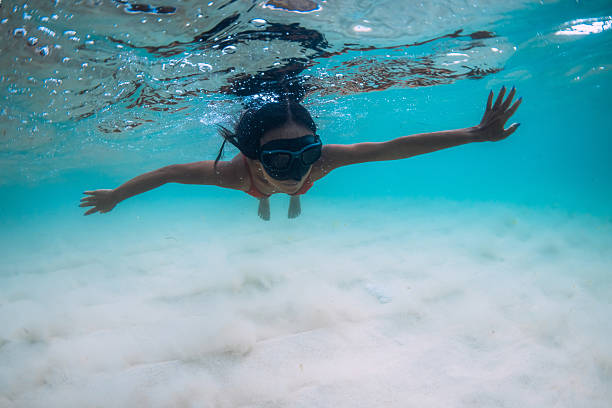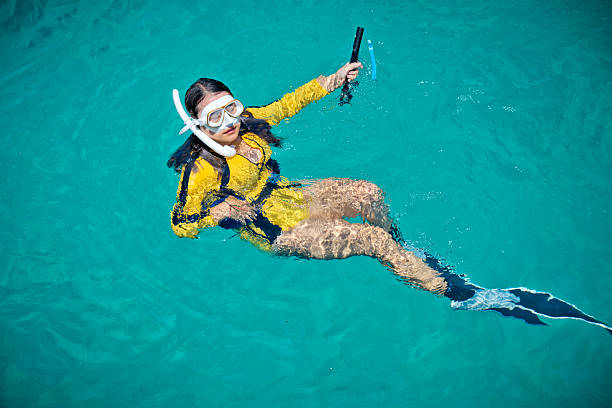Ever wondered why low volume mask for freediving? The right mask can transform your underwater experience. A low volume mask helps you equalize with ease, saves air, and ensures a comfortable dive. Whether you’re gliding through shallow waters or pushing deeper, this guide will help you choose the perfect mask for your needs. Let‘s dive in!
What Is a Low Volume Freediving Mask?

A low volume freediving mask is built with very little space inside the frame, keeping the lenses close to your eyes and the air pocket as small as possible. This compact design is exactly what makes a low volume freediving dive mask so efficient underwater. Because it traps less air, you use less of your own breath to equalize, which is a real advantage during deep dives. With less air to manage, your descent feels smoother and your attention stays on technique rather than pressure changes.
You’ll also notice that a low volume dive mask sits securely on your face and gives you a clearer, more controlled view underwater. It stays stable during fast drops, and the reduced volume helps prevent mask squeeze at depth. In short, this type of mask supports the way you dive—efficient, streamlined, and comfortable from the first meter to the last.
High Volume vs Low Volume Dive Mask: Key Differences
When you compare a high volume vs. low volume dive mask, it helps to understand that both can be used in the water, but they serve very different purposes. A high-volume mask works fine for mergulho com snorkel and shallow, casual freediving. But once you begin diving deeper, even past 10–15 meters, it starts to demand far more air for equalization. For freedivers—who dive on one breath—this becomes a clear disadvantage.
A low volume mask, on the other hand, is built around freediving needs. It keeps the internal air space small, which means you use much less air to equalize and stay more relaxed during descent. This is why almost every serious freediver relies on a low volume design.
How They Compare for Freediving Performance
| Feature (freediving relevance) | High Volume Dive Mask | Low Volume Dive Mask |
| Suitable for freediving? | Only for shallow, casual dives | Ideal for all depths; designed for freediving |
| Internal Air Space | Large — requires more equalization | Minimal — equalizes quickly with little air |
| Air Use at Depth | High; inefficient for breath-hold | Very low; preserves air for the dive |
| Mask Squeeze Risk | Higher on deeper dives | Lower — easier to manage |
| Stability During Descent | Slight shifting under pressure | Very stable and predictable |
| Hydrodynamic Drag | Higher drag; bulkier | Streamlined; easier to move fast |
| Best Use Case | Scuba diving, snorkeling | Freediving, spearfishing, deep diving |
Why Freedivers Prefer Low Volume Masks at Depth

Once you start moving past the shallow zone, pressure builds quickly, and your mask is one of the first pieces of gear to feel it. A low volume máscara de mergulho livre gives you several clear benefits at depth, and most of them directly affect how smoothly and comfortably you dive.
1. You use far less air for equalization
A low volume máscara de mergulho has a much smaller internal space, so you only need a minimal amount of air to equalize it during descent. This saves you effort and helps you keep more air where it matters—your lungs. By the time you reach 10 to 15 meters, the difference is obvious. A high-volume design often interrupts your rhythm because it needs more frequent equalizing. A low volume option allows you to stay focused on your descent instead of your mask.
2. Your descent rhythm becomes smoother
When you are not stopping every few meters to add air to your mask, your movement feels more natural. A low volume freediving dive mask supports a steady finning pattern and better body control. You stay relaxed, your pace stays consistent, and you can follow the line or explore the reef without breaking your flow.
3. You lower the chance of mask squeeze
As you go deeper, outside pressure increases. If your mask holds a lot of air, that space collapses harder and creates more pull on your face. This is what leads to mask squeeze. A low volume mask reduces that effect because there is less air for the pressure to compress. It feels more stable on your face and stays comfortable even as you approach deeper zones.
4. You get clearer vision at depth
Most low volume designs place the lenses closer to your eyes, which naturally improves clarity and widens your field of view. This helps a lot when visibility becomes limited at depth. You can read the dive line more easily, see your buddy, and maintain better orientation. The closer lens distance also reduces distortion, so the underwater world feels sharper and more natural.
5. You stay calmer throughout the dive
Relaxation is one of the core skills in mergulho livre. When your mask handles pressure well, demands less air, and doesn’t distract you, it becomes easier to stay calm. This supports longer bottom time, steadier technique, and overall better performance. A low volume freediving mask works with your body instead of against it, which is why so many freedivers rely on it for deeper dives.
How to Choose the Right Freediving Mask
Choosing the right low volume freediving mask is about finding a balance between fit, comfort, and performance. You want a mask that fits perfectly, seals well, and offers you a clear view. A poor fit will defeat the purpose of the low volume design, so let’s break down the key things to consider:
1. Faceplate Material and Skirt Design
The skirt is the part of the mask that seals against your face, and it must be made of soft, high-quality silicone for a reliable fit.
- Silicone Durometer: Look for a medium-to-soft silicone. This softer material conforms better to your face, creating a tighter seal without needing to tighten the straps too much.
- Cor: Clear silicone brightens the view underwater, but it can create peripheral distractions. If you prefer focusing only on the target, black silicone helps block light and reduces outside distractions, which many deep divers prefer.
2. Lens Shape and Frame Design
Freediving masks come in two main styles: framed and frameless. Both have their pros and cons.
- Frameless: These masks are usually the lowest volume, with the silicone skirt bonded directly to the lens. This design keeps the lens very close to your eyes and offers a wider, more natural field of view.
- Dual-Lens: If you need prescription lenses, dual-lens masks may be the better option. They are still low-volume, but they make it easier to swap out lenses.
3. Face Shape Fit: The Critical Test
The most important factor is how well the mask fits your face. A low volume mask that leaks is worse than a high volume mask that fits well.
- The Inhale Test: Place the mask on your face without the strap, and gently inhale through your nose. If the mask stays suctioned to your face, you’ve got a good seal.
- Nose Pocket: Ensure the nose pocket is easy to access for equalization. You should be able to pinch your nose comfortably, even with gloves on. A cramped nose pocket will make equalization harder, so this is key to deep diving performance.
4. Intended Use
Even though a low-volume mask is the best option for all freedivers, the specific features you might prefer depend on your diving style and needs.
- If you’re a deep diver or focusing on competitive diving (like Constant Weight), a minimalist, frameless low-volume mask is likely your best choice. This design is compact, allowing for efficient equalization, minimizing air consumption, and making your descent much more comfortable at greater depths.
- If you’re a recreational diver or spearfisher spending most of your time in shallow water, you may prefer a low-volume mask with dual lenses. The dual-lens design offers a slightly wider field of view while still keeping the low-volume benefits, so you can easily equalize and stay comfortable on your dives.
How to Get the Best Performance From Your Low Volume Mask

Owning a top-quality low volume mask is just the beginning. To get the most out of it, there are a few key maintenance and usage tips that will ensure your mask stays in peak condition and helps you dive with ease.
Cleaning and Anti-Fogging Preparation
New masks often come with a thin silicone layer inside the lenses, which can cause fogging. Here’s how to get rid of it before your first dive:
- Initial Cleaning: Use non-gel toothpaste (without micro-beads) to gently scrub the inside of the lens with a soft cloth or your fingers. This will remove the silicone residue that causes fogging. Rinse it thoroughly. Don’t use abrasive pads or sharp objects.
- Pre-Dive Fog Prevention: Apply a small amount of commercial anti-fog solution to the inside of the lenses, or use a drop of saliva. Rub it around the lens and rinse lightly. This creates a thin film that prevents fogging during your dive.
Usage Tips and Equalization Technique
- Strap Tension: Don’t overtighten the mask strap. The strap is just there to keep the mask in place; it’s the silicone skirt that makes the seal. Too much tension can warp the skirt and lead to leaks.
- Hair Management: Make sure no hair is caught between your face and the silicone skirt, especially around the temples and neck. Hair can break the seal and let water in, so smooth it back before putting on your mask.
- Low Volume Equalization: Equalizing a low volume mask takes precision. Since only a small amount of air is needed to equalize, many experienced freedivers use a controlled exhale that’s a side effect of their ear equalization technique. Avoid exhaling a large burst of air into the mask. Instead, learn to release small amounts of air when needed.
By following these simple steps, you’ll maximize the comfort, performance, and lifespan of your low volume mask, making every dive easier, safer, and more enjoyable.
Considerações finais
A good freediving mask makes a huge difference in your dive. Low volume masks are essential for maximizing comfort, air conservation, and equalization as you go deeper. When you choose the right freediving mask, you’re setting yourself up for better dives.
No Vanguard Swimming, we design masks that meet the needs of freedivers like you. With a perfect fit, durability, and a focus on performance, our low volume masks help you dive smarter and more comfortably.
Ready to dive in? Explore our range of freediving masks and find the perfect fit for your next adventure.


